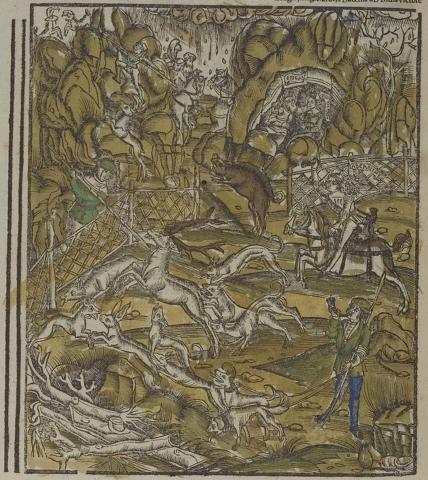Annotations
In the foreground, Ascanius and another youth corner several wild beasts, including a rabbit, a deer and a boar (156-9) into a net, while a third hunter, standing behind the net, prepares to spear the deer. In the background, to the left, hunters pursue wild goats on a rocky hill (151-55). To the right, a storm of rain and hail has driven Aeneas and Dido into a small cave where they embrace (165-72). This is one of a few Brant illustrations with some amount of color; it seems probable that the color was added later. (Katy Purington)
Woodcut illustration from the “Strasbourg Vergil,” edited by Sebastian Brant: Publii Virgilii Maronis Opera cum quinque vulgatis commentariis expolitissimisque figuris atque imaginibus nuper per Sebastianum Brant superadditis (Strasbourg: Johannis Grieninger, 1502), fol. 214v, executed by an anonymous engraver under the direction of Brant.


Sebastian Brant (1458–1521) was a humanist scholar of many competencies. Trained in classics and law at the University of Basel, Brant later lectured in jurisprudence there and practiced law in his native city of Strasbourg. While his satirical poem Das Narrenschiff won him considerable standing as a writer, his role in the transmission of Virgil to the Renaissance was at least as important. In 1502 he and Strasbourg printer Johannes Grüninger produced a major edition of Virgil’s works, along with Donatus’ Life and the commentaries of Servius, Landino, and Calderini, with more than two hundred woodcut illustrations. (Annabel Patterson)